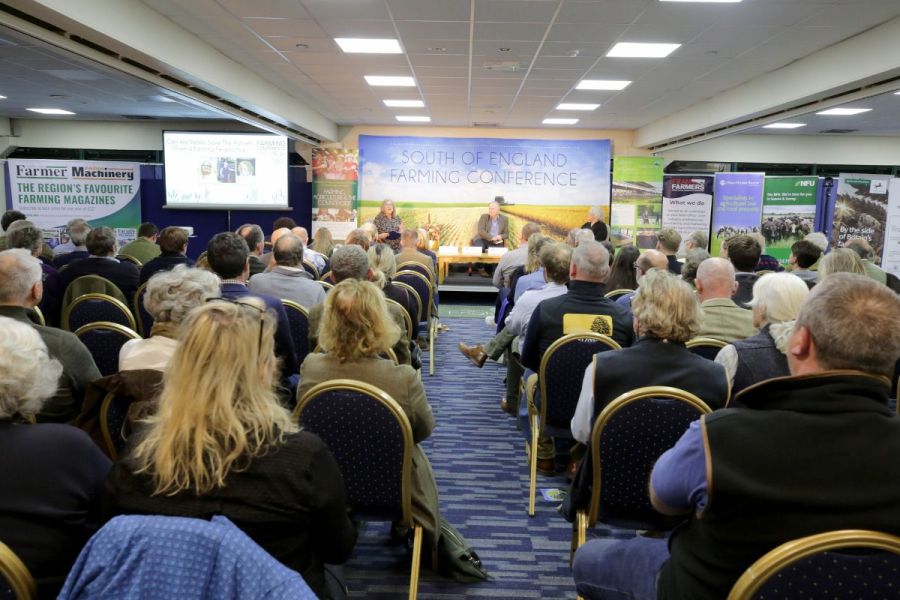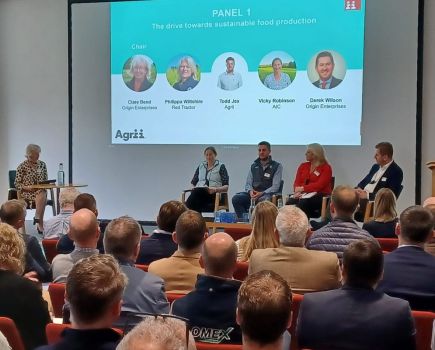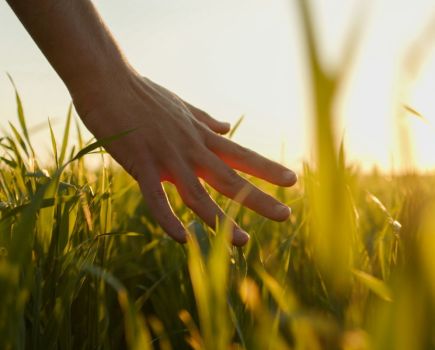Farming finds itself at the centre of discussions in its role as both hero and villain as the UK plots its course to net zero. But can farming really save the planet? CPM reports from the South of England Agricultural Society conference, which asked that very question.
“Farmers feel that they’re holding a great deal of the risk, and struggling to get a fair reward for the work they’re putting in.”
By Lucy de la Pasture
Reducing global greenhouse gas emissions has become a part of life in the 2020s as industries and populations seek to meet the global 2050 net zero target – with varying degrees of enthusiasm. Within that arena of change, farming is uniquely positioned as being a significant source of emissions, but also as a part of the solution with its potential to sequester more carbon.
But for farmers operating in a food system that’s widely described as ‘broken’, it’s become a confusing environment with changing policy goalposts, and an ever more demanding marketplace that’s reluctant to reward farmers for their environmental efforts.
These issues were discussed at the South of England Agricultural Society conference, where Phil Jarvis, chair of Albanwise Farming and Environment and of the Voluntary Initiative, and organic farmer Sue Pritchard, chief executive of independent charity, the Food, Farming, and Countryside Commission, gave their views.
In a wide-ranging discussion, hosted by BBC Radio 4 journalist Charlotte Smith, the panellists were asked the question, can farming save the planet? The consensus was that there really isn’t a choice, the alternative is pretty grim. As Sue put it: “The question is not can we, but how can we?
“Across so many sectors, we’re stepping into a future that we don’t have a blueprint for,” she commented. “We can see the effects around us now with more disruptive weather, but we are now seeing data coming through that might suggest we’re going to be reaching tipping points sooner than we’d expected. We don’t know what impact that’s going to have.”
With flooded fields and named storms charging cross the country one after the other during late autumn/early winter, farmers are certainly feeling on the frontline of climate change. But it’s not just weather challenges farmers are facing, Phil highlighted.
“Market volatility, strategy and policy, the current global situation, and even social media – where everyone has an opinion – can all feel overwhelming at times. However, farmers are tasked to primarily produce food, but the future will require wider land management.”
Navigating the pressures of a changing world isn’t easy. Phil recommended not to forget the fundamentals: “First and foremost, business planning is really important. You need to make the figures stack up, whichever way you farm, so that it’s financially sustainable.
“Secondly, we already know the direction of change with things like the Sustainable Farming Incentive (SFI), but how can you grasp it so that you have win-wins? It maybe you can get paid for an SFI option that might help you, for example, by reducing your fertiliser bill.”
When it comes to farming in a more sustainable way, regenerative farming is often cited as the answer. Sue reasoned that agroecology is a better term.
“I’m somewhat agnostic about the word regenerative because it’s not properly defined and, already, we’re seeing all sorts of examples of greenwashing – supply businesses are using the term regenerative to mean utterly meaningless things.
“Agroecology is carefully defined and is about the whole system of food and farming, not just about on-farm practices, such as no-till, minimal use of artificial chemicals, keeping the soil covered and so on. It also encompasses topics we very rarely mention, such as the governance of food systems and farming.
“At the moment, farmers feel that they’re holding a great deal of the risk, and are struggling to get a fair reward for the work they’re putting in. And there are some players in the whole food system whose profits are increasing by big margins.
“Agroecology shines a light on those parts of the whole of the food system, and the farming system, that for many people are invisible. And it encourages sharp questions about whether it’s organised in the fairest, most sustainable way for everybody.”
Phil believes that whatever a farmer may think about the concept, there are pillars of regenerative systems that may help them achieve the ultimate aim, which is keeping profit on the farm. For example, reducing cultivation will bring down machinery and fuel costs, overtime etc. Soil cover and living roots can reduce soil erosion. “So can you make them work for you?” he challenged.
The conversation about retaining profitability on the farm soon led into a conversation about who should be paying for this more sustainable direction of travel, highlighting the discussions around Red and Green Tractor.
“All of the component parts needed to build more resilience in your farm has a cost. It can have an immediate cost, but it also has a consistent cost,” said Sue.
“We’ve got a dysfunctional marketplace,” added Phil. “In fact, what we do now and what we’re expected to do in the future are not really being rewarded. Somewhere along the line, someone wants to take those credentials and put them on the front of their food but doesn’t necessarily want to buy them from you.”
The language used around the SFI in mainstream and social media is something Sue believes isn’t helpful. She made the point that when farming is talked about, a lot is made of the subsidies that farmers have received, but the reality is subsidies go to all sorts of other industries.
“You never hear that language used in any other sector. You don’t hear about the subsidy paid to house builders and you don’t hear about the subsidy paid to the energy companies, or the subsidy that fossil fuel companies are getting right now when they need to be investing so much more in renewables.
“So when government was investing in renewable energy and using devices like the feed-in-tariffs, that was considered to be an entirely appropriate economic incentive to help shift a whole sector from where it was to where it needs to be. That’s the language we should be using about our sector. Not that farmers are getting subsidies, but government is investing and helping farming move to a sustainable and resilient footing.”
With figures just out that show low initial uptake of the SFI, could it be that government doesn’t have it right? “It’s one thing having a policy and it’s another getting a coherent implementation of it,” suggested Phil. “For those that signed up early, it was somewhat frustrating to learn the rules were being changed. But I still think it’s a source of income that’s worth pursuing if you have the patience to follow the scheme.”
Sue’s concerns are about inequality. “Wales has already said that it’s not going to be supporting organic farming anymore. So for those of us who have been doing really good work already, because it was important for us to do so, we don’t have much additionality to add. In fact, we put in hedgerows and riparian corridors. I’ve got lots of woodland on my farm already, as well as unimproved species-rich grassland.
“The impact is greatest on upland farms, where we’re already hearing stories of large land managers ending tenancies. We’re seeing what some people might call a clearance from the uplands because those landowners can maximise their income by rewilding or natural capital solutions. And I think that that ought to really give us pause.”
It’s these unintended consequences that worry Phil too. “If you’re a grassland farmer in certain parts of the country, or organic farmers where there aren’t many options, government has been saying, ‘you’re already doing this’. But what they don’t realise is that what these farmers were already doing is protecting the very asset they want protecting. If government isn’t not careful, it will drive them to either stop doing those practices or change to something more environmentally damaging where they think they can make more money.”
So how can this process of change be better facilitated? Sue highlighted the ‘change equation’, explaining there are three components to any really effective change process.
“It asks what’s the need for change, and if this version of the future is going to be better. And it helps identify the means and the methods to get to that new future. By working through this process, it highlights that the value of the actions required to make the changes have to be greater than the pain or the cost of change. And I don’t think we’ve done this – government hasn’t, and I don’t think we’ve really talked through all of the elements of those components as a society.”
Applying this reasoning, why do we need to change? “There are some folk in farming and in other sectors who are very happy with the way things are at the moment. Elements of the farming value chain are profiting extremely well from the way things work right now. So they don’t have a huge incentive to change unless we can create some other incentives to do so,” said Sue.
“The reality is some farmers will invest in more regenerative practices on their farm, and others are already well sorted. Then there’s those who say they’ll farm intensively and take their chances in the marketplace – they’re all doing what they think is best for their farm business.”
And when it comes to the means and methods of transition, the tools are widespread, she said. “There are many different carbon calculators, for instance, and unregulated natural capital markets. Who’s making sure the right guardrails are in place so that people aren’t exploited by those who know their way around natural capital markets more effectively? There’s lots of elements in this process that just are under-thought.”
Phil doesn’t believe government has a coherent plan about food, farming and the environment and that leadership is lacking. He was dismissive of the codesign process for SFI. “I think SFI has been consulted on and then government has written the rules.”
So, would a strategy be helpful? “If you have a strategy on your farm, firstly you identify your aims and objectives. Then you work out how you’re going to get there. Then you measure whether it’s successful. That is a strategy as far as I can see. It’s three sentences and not 154 pages,” said an exasperated Phil.
But perhaps government-led strategy isn’t the answer to the sort of change agriculture is facing, chipped in Sue. “The reality is that some things lend themselves to strategy, things that are predictable, and that you can plan for, and that you will have control over.
“We’re talking about something a bit more complicated because we’re part of a global food system where we have little control over global commodity traders, global chemical companies, global food processers, such as Nestle, Unilever, PepsiCo. They have interests in the food system that are about maximising shareholder value, and they’re operating in multiple political jurisdictions in countries all over the world to maximise value for themselves. So when we talk about strategizing in the UK, we can’t really do it without absolute cognisance of the complexity that we’re operating in.”
“But you can set frameworks in which people can make choices,” she noted. In reality, the farming sector is so diverse, every farmer has to be able to establish their own strategy in the particular conditions and contexts that they’re operating in, believes Sue. “It would be an absolute disaster if government tried to set a strategy because it’s not within its gift to make it happen for the whole of the sector.
“Government needs to set the framework, or direction of travel, and put the policy levers in place, and the policy and business guardrails for people who are choosing that direction of travel.”
Phil agreed. “There’s a big enough marketplace, with enough produce coming from all over the world that we can’t grow. But where we can grow produce, we should be supporting farmers to do just that.”
How exactly that will happen, and ‘how it might save the planet’, is still very much a hot topic of debate.
This article was taken from the latest issue of CPM. For more articles like this, subscribe here.
Sign up for Crop Production Magazine’s FREE e-newsletter here.




